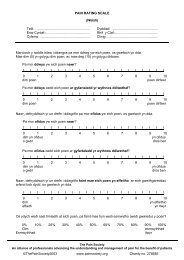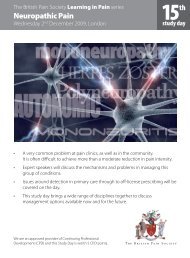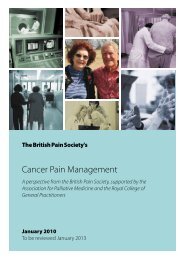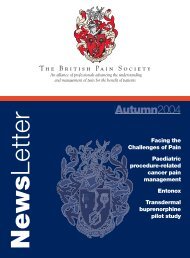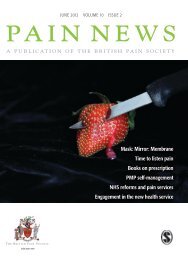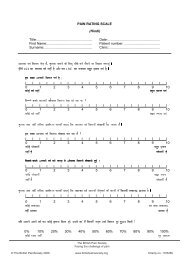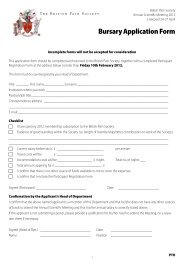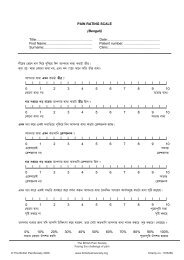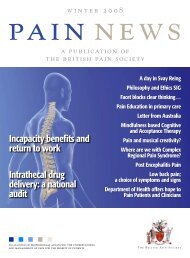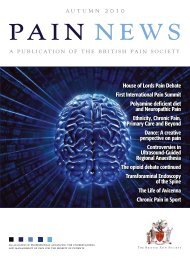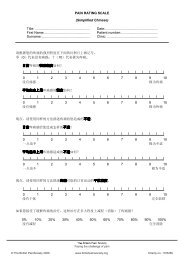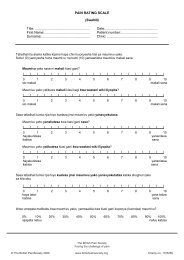Summer 2010 - The British Pain Society
Summer 2010 - The British Pain Society
Summer 2010 - The British Pain Society
Create successful ePaper yourself
Turn your PDF publications into a flip-book with our unique Google optimized e-Paper software.
i SAFE USE OF PAINKILLERS<br />
• When taken at the right dose, OTC painkillers are safe and effective medicines.<br />
• When you have short-term pain it may be best to take the painkiller as recommended on the pack to<br />
stop the pain from building up and becoming intolerable.<br />
• If you need to take painkillers for longer than three days you should see your doctor or pharmacist<br />
for advice.<br />
• If you feel the dose of a prescription medicine isn’t enough, don’t ‘top up’ with painkillers bought over<br />
the counter - Talk to your doctor or pharmacist.<br />
• Speak to your doctor or pharmacist if you need advice.<br />
i<br />
MANAGE YOUR PAIN EFFECTIVELY AND SAFELY<br />
WITH OTC MEDICINES<br />
Diclofenac<br />
Naproxen<br />
• Dihydrocodeine in combination<br />
with paracetamol<br />
• Paracetamol<br />
• Aspirin<br />
• Ibuprofen<br />
• Codeine – only available as a<br />
combination with paracetamol,<br />
or aspirin, or ibuprofen<br />
Always read the instructions and do not take two products containing the same active ingredient. Codeine<br />
or dihydrocodeine containing painkillers should only be used for short-term treatment of acute, moderate<br />
pain which is not relieved by paracetamol, ibuprofen, naproxen, diclofenac, or aspirin alone. Some OTC<br />
painkillers can only be used to treat specific conditions.<br />
i ALWAYS READ THE INSTRUCTIONS AND<br />
INFORMATION IN THE LEAFLET AND PACK<br />
• It can be dangerous to take more than one painkiller with the same active ingredient. Make sure you<br />
know the ingredients of the products that you are taking.<br />
• If you have conditions like asthma, any stomach problems or if you are taking certain medicines, then<br />
some painkillers may not be suitable for you and you should speak to your pharmacist or doctor about<br />
which painkiller would suit you best. Always read the instructions and information in the leaflet and pack.<br />
• Some people may have side-effects when taking medicines. You can help to make sure that<br />
medicines remain as safe as possible by reporting any unwanted side-effects via the internet at<br />
www.yellowcard.gov.uk or through your pharmacy.<br />
i UNDERSTAND WHAT YOU ARE TAKING<br />
• Keeping a pain and medicine diary can ensure that you are using your painkillers most effectively.<br />
• Never take painkillers more frequently than it says on the instructions on pack or in the leaflet.<br />
• Always read the names of the ingredients and information on the leaflet and pack.<br />
• Never take another product sooner than you should.<br />
Your pharmacist and their assistants can advise you on an appropriate choice of product.<br />
You do not always need painkillers to<br />
relieve pain<br />
• Applying heat to the skin can help some types<br />
of pain. Use compresses or products such as<br />
sprays, creams, ointments, gels and patches to<br />
help swelling and inflammation.<br />
• Support from bandages or compression hosiery<br />
can help with sprains and strains.<br />
• Acupuncture or Transcutaneous Electrical Nerve<br />
Stimulation (TENS) are alternatives to<br />
medication for pain control. Ask a healthcare<br />
professional about these treatments.<br />
• Rest if your body tells you to.<br />
• Exercise gently as soon as you are able to.<br />
Ask yourself what is causing the pain. If you do not<br />
know, if the pain persists for more than three days,<br />
or if you are unwell, always seek medical advice.<br />
What kinds of pain can be helped by<br />
OTC medicines?<br />
• Headache, migraine<br />
• Toothache<br />
• Period pain<br />
• Minor injuries, strains and sprains<br />
• Backache, muscle aches, joint pains<br />
How do different painkillers work?<br />
Aspirin, ibuprofen, diclofenac and naproxen<br />
come from a group of drugs called nonsteroidal<br />
anti-inflammatory drugs (NSAIDs). NSAIDs work by<br />
changing the body’s response to pain and swelling.<br />
<strong>The</strong>y are particularly helpful for acute strains and<br />
sprains, muscle and joint pains.<br />
Codeine and dihydrocodeine are similar to, but<br />
weaker than morphine, and work by blocking pain<br />
messages in the brain and spinal cord.<br />
Paracetamol works in a different way to NSAIDs<br />
and codeine. It is particularly helpful in reducing<br />
fever and relieving pain.<br />
Because each type of painkiller works in a<br />
different way to relieve pain, there are some<br />
products available that contain more than<br />
one type of painkiller. For example aspirin,<br />
paracetamol or ibuprofen can be combined<br />
with codeine and/or caffeine.<br />
What do the other ingredients do?<br />
Some painkillers contain caffeine as it may improve<br />
pain relief. Caffeine, also in coffee and tea, is a<br />
stimulant. It increases blood pressure and speeds up<br />
the heart. <strong>The</strong>re is about 75 mg caffeine in a small<br />
cup of coffee and about 50 mg in a small cup of<br />
tea, similar amounts to some OTC painkillers.<br />
Increasing caffeine intake may increase the<br />
risk of nervousness and dizziness.<br />
Doxylamine, a sedating antihistamine, has<br />
muscle relaxing properties thought to be<br />
beneficial in headache.<br />
Does your pain affect your life?<br />
Long-term pain can often affect your quality of life.<br />
Ask yourself:<br />
• Do you need to take this medicine continuously<br />
for more than three days?<br />
• Do you have low moods?<br />
• Do you suffer from a lack of sleep?<br />
• Are you tired and irritable often?<br />
• Do you find it difficult to concentrate?<br />
• Does the pain make it difficult for you<br />
to exercise?<br />
If you answer “yes” to any of these questions<br />
then you need help in managing your symptoms<br />
and it is important that you talk to your doctor.<br />
Although it may not always be possible to get rid<br />
of pain completely, there is a range of different<br />
treatments available.<br />
!<br />
BEWARE! MEDICINES HAVE<br />
MORE THAN ONE NAME<br />
A brand name is the name chosen by a<br />
manufacturer (e.g. Panadol®, Nurofen®, Voltarol®,<br />
Feminax®). Each drug may have several different<br />
brand names. <strong>The</strong> “active ingredient” describes the<br />
drug (e.g. paracetamol, ibuprofen, diclofenac and<br />
naproxen). Always read the instructions and<br />
do not take two products with the same active<br />
ingredient. Make sure you know the ingredients<br />
of the products that you are taking. <strong>The</strong>se will be<br />
clearly marked on the pack.<br />
NEWS<br />
Economics and Utility of<br />
Diamorphine Use<br />
In November of 2009 the Drugs<br />
Licensing and Compliance Unit<br />
of the Home Office released<br />
a consultation paper on the<br />
Oxycodone import policy of the UK<br />
government.<br />
<strong>The</strong> Government regulates the<br />
possession, supply, production and<br />
international trade in controlled<br />
drugs. Long-standing government<br />
policy has been to allow the import<br />
of controlled drugs from outside<br />
the EEA only if those drugs are not<br />
available from within the European<br />
Economic Area (EEA). This policy<br />
applied to oxycodone in the same<br />
way that it applied to all other<br />
controlled drugs. In 2008, following<br />
representations from within the<br />
UK pharmaceutical industry that<br />
this policy was too restrictive, the<br />
Government amended its policy<br />
to allow oxycodone imports from<br />
outside the EEA provided that all<br />
imports were re-exported. However,<br />
in 2009 the Government decided to<br />
revert to its previous policy on the<br />
grounds that import for re-export<br />
posed an unacceptable risk to the<br />
UK’s access to diamorphine. A<br />
consultation process has occurred<br />
with the home office and interested<br />
parties have made submissions<br />
including the BPS. A review of the<br />
utility of diamorphine is presented<br />
at a later point in this edition.<br />
NEWS<br />
House of Commons debate<br />
into Musculoskeletal<br />
Conditions<br />
On Tuesday 19 January <strong>2010</strong> in the<br />
House of Commons a wide ranging<br />
and informative debate into the<br />
management of musculoskeletal<br />
conditions (MSK) occurred. As many<br />
will know the Department of Health<br />
has published a framework for<br />
managing musculoskeletal conditions.<br />
This debate was brought by Paul<br />
Rowen, Liberal MP for Rochdale.<br />
<strong>The</strong> debate had contributions from<br />
many MPs and <strong>The</strong> Parliamentary<br />
Under-Secretary of State for Health<br />
Ann Keen MP responded on behalf of<br />
the government.<br />
Key issues discussed were:<br />
• <strong>The</strong> need for better co-ordination<br />
and integration of services for<br />
patients with musculoskeletal pain.<br />
• <strong>The</strong> variability of services across<br />
the country and the need for<br />
more robust PCT commissioning.<br />
• <strong>The</strong> importance of patients being<br />
able to access a multidisciplinary<br />
team.<br />
• <strong>The</strong> need for better education and<br />
training, particularly for GPs, in<br />
MSK conditions.<br />
It was proposed that a post of clinical<br />
director for musculoskeletal conditions<br />
(tsar) could be considered to<br />
coordinate this work. <strong>The</strong> Chronic <strong>Pain</strong><br />
Policy Coalition (CPPC) in conjunction<br />
with other stakeholders is working<br />
hard to arrange for a UK <strong>Pain</strong> Summit,<br />
similar to the recent Australian <strong>Pain</strong><br />
Summit, to occur soon.<br />
PAI N N E W S S U M M E R <strong>2010</strong> 29




